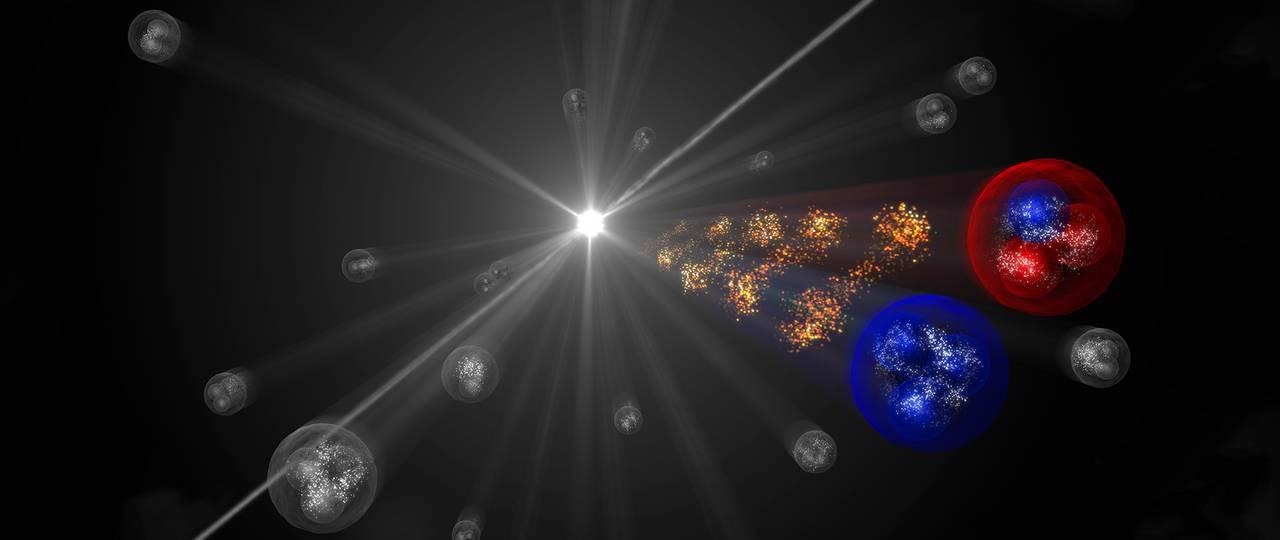Dec 10 2020
Within the atomic nuclei, the positively charged protons should, in fact, repel each other. However, even heavy nuclei with numerous neutrons and protons stay bound together. This is feasible due to the so-called strong interaction.
 Using collision data from the ALICE detector at the Large Hadron Collider at CERN, the strong interaction between a proton (right) and the rarest of the hyperons, the omega hyperon (left), which contains three strange quarks, was successful measured with high precision. Image Credit: D. Dominguez/CERN.
Using collision data from the ALICE detector at the Large Hadron Collider at CERN, the strong interaction between a proton (right) and the rarest of the hyperons, the omega hyperon (left), which contains three strange quarks, was successful measured with high precision. Image Credit: D. Dominguez/CERN.
At the Technical University of Munich (TUM), Prof. Laura Fabbietti and her research team have now devised a technique to accurately measure the strong interaction with the help of particle collisions in the ALICE experiment at CERN in Geneva.
The strong interaction, which is one of the four fundamental forces in physics, is mainly responsible for the occurrence of atomic nuclei with several neutrons and protons. Neutrons and protons are formed of smaller particles called quarks. The strong interaction even binds the quarks together.
As part of the ALICE (A Large Ion Collider Experiment) project at CERN in Geneva, Prof. Laura Fabbietti and her research team from TUM have now created a high-precision method to identify the forces acting between protons and hyperons—unstable particles made of the so-called strange quarks.
The measurements are not just revolutionary in the field of nuclear physics but also crucial to gain insights into neutron stars, one of the most fascinating and enigmatic objects in the universe.
Comparison Between Theory and Experiment
In nuclear physics, one of the main prevalent challenges is to gain insights into the strong interaction between particles with different quark content from first principles—that is, beginning from the strong interaction between the constituents of the particles (the quarks and the gluons) that transmit the interaction force.
The theory related to the strong interaction can be employed to identify the strength of the interaction. But these calculations do not offer reliable estimations for normal nucleons consisting of up and down quarks, but for nucleons made of heavy quarks, like hyperons, containing one or more strange quarks.
Experiments to identify the strong interaction are very challenging since hyperons are unstable particles that decay fast after production. Thus far, this challenge has hindered a meaningful comparison between theory and experiment. The approach used by Prof. Laura Fabbietti now paves the way for high-precision analyses of the dynamics of the strong force at the Large Hadron Collider (LHC).
Measurement of the Strong Force Even for the Rarest Hyperon
Four years ago, Prof. Fabbietti, professor for Dense and Strange Hadronic Matter at TUM, suggested the use of a method known as femtoscopy to analyze the strong interaction at the ALICE experiment. The method enables analysis of spatial scales close to 1 fm (10−15 m)—almost the size of a proton—and the spatial range of the strong-force action.
At the same time, Prof. Fabbietti’s team at TUM could not just investigate the experimental data for a majority of the hyperon-nucleon combinations but was also successful in quantifying the strong interaction for the Omega, the rarest of all hyperons, which constitutes three strange quarks. Moreover, the team also created its own framework that helps to make theoretical predictions.
My TUM group has opened a new avenue for nuclear physics at the LHC, one which involves all types of quarks, reaching an unexpected precision in a place nobody has looked so far.
Laura Fabbietti, Professor for Dense and Strange Hadronic Matter, Technical University of Munich
The study published recently in Nature describes only a few of the several interactions quantified for the first time.
Do Neutron Stars Contain Hyperons?
It is also very crucial to understand the interaction between nucleons and hyperons to test the hypothesis of whether neutron stars include hyperons. The forces acting between the particles have a direct impact on a neutron star’s size.
To date, the relationship between the radius and the mass of a neutron star is not known. Prof. Fabbietti’s research in the future will thus also enable solving the puzzle of the neutron stars.
Journal Reference:
ALICE Collaboration (2020) Unveiling the strong interaction among hadrons at the LHC. Nature. doi.org/10.1038/s41586-020-3001-6.